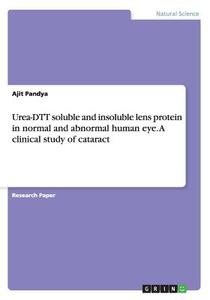
Urea-dtt Soluble And Insoluble Lens Protein In Normal And Abnormal Human Eye. A Clinical Study Of Cataract
- Editore:
Grin Publishing
- EAN:
9783668030558
- ISBN:
3668030553
- Pagine:
- 16
- Formato:
- Paperback
- Lingua:
- Tedesco
Descrizione Urea-dtt Soluble And Insoluble Lens Protein In Normal And Abnormal Human Eye. A Clinical Study Of Cataract
Research Paper (postgraduate) from the year 2015 in the subject Chemistry - Bio-chemistry, C. U. Shah Science College, course: Biochemistry, language: English, abstract: A socio-economic cause of visual defect during aging is not only an important health problem but also one, especially in tropical countries. Inhibiting or cure in the progression would present a major achievement for human welfare and is therefore one of the priorities of medical research in India. 41 million people are blind globally of which 17 million people are experiencing profound or total loss of vision due to cataract. More than 5 million cataract surgeries are carried out in many third world countries including India. The enzymes associated with the synthesis, catabolism and utilization of glutathione, ascorbic acid and proteins in the lens have been reported with the progression of cataract. It shows increase percentages of urea DTT soluble (UDTTS) and urea DTT insoluble (UDTTIS) fraction in all types of cataractous lenses. The results presented in the current study show that both cataract formation and normal ageing are accompanied by a decrease in the solubility of the lens proteins. Most of the color of the lens is associated with urea-insoluble protein fractions. Amongst urea-insoluble fraction, the brown protein fraction was more predominant over yellow protein fraction.

